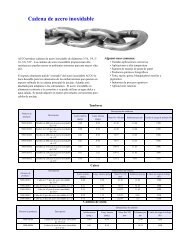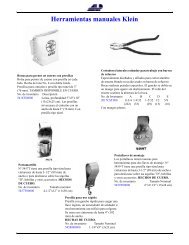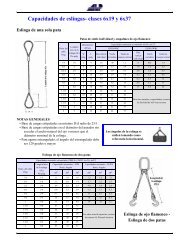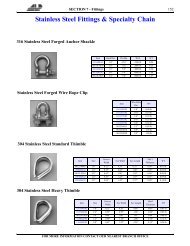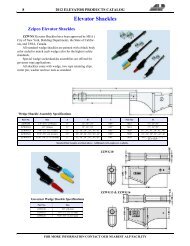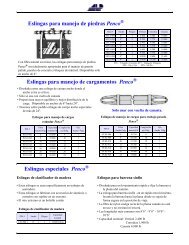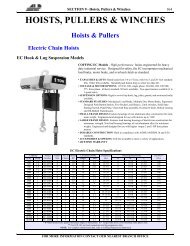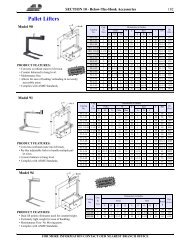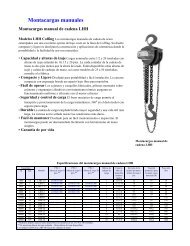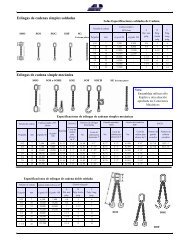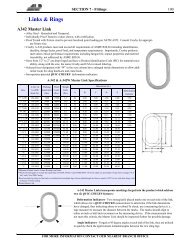General Products - ALP Industries Inc.
General Products - ALP Industries Inc.
General Products - ALP Industries Inc.
- No tags were found...
You also want an ePaper? Increase the reach of your titles
YUMPU automatically turns print PDFs into web optimized ePapers that Google loves.
SECTION 7 - Fittings 108Hoist HooksHoist HooksWarnings and Application InstructionsS-3319 S-319 S-320 S-322 S-3322BSeries Series SeriesPositioning OnlyImportant Safety Information - Read and Follow• A visual periodic inspection for cracks, nicks, wear, gouges and deformationas part of a comprehensive documented inspection program,should be conducted by trained personnel in compliance with theschedule in ANSI B30. 10.• For hooks used in frequent load cycles or pulsating loads, the hookand threads should be periodically inspected by Magnetic Particle orDye Penetrant. (Note: Some disassembly may be required).• Never use a hook whose throat opening has been increased, or whosetip has been bent more than 10 degrees out of plane from the hookbody, or is in any other way distorted or bent. Note: A latch will notwork properly on a hook with a bent or worn tip.• Never use a hook that is worn beyond the limits shown in Figure 1.• Remove from service any hook with a crack, nick, or gouge. Hookswith a crack, nick, or gouge shall be repaired by grinding lengthwise,following the contour of the hook, provided that the reduced dimensionis within the limits shown in Figure 1.• Never repair, alter, rework, or reshape a hook by welding, heating,burning, or bending.• Never side load, back load, back load, or tip load a hook. (Side loading,back loading and tip loading are conditions that damage andreduce the capacity of the hook.) (See Figure 2.)• Eye hooks, shank hooks and swivel hooks are designed to be usedwith wire rope or chain. Efficiency of assembly may be reducedwhen used with synthetic material.• Do not swivel the S-322 swivel hook while it is supporting a load.The S-322 is distinguishable by hex nut and flat washers.• The S-3322 swivel hook is designed to rotate under load. The S-3322is distinguishable from the S-322 by use of a round nut designed toshield bearing.• The use of a latch may be mandatory by regulations or safety codes;e.g., OSHA, MSHA, ANSI/ASME B30, Insurance, etc. (Note: Whenusing latches, see instructions in “Understanding: The Crosby GroupWarnings” for further information.)• Always make sure the hook supports the load. (See Figure 3). Thelatch must never support the load (See Figure4).• When placing two (2) sling legs in hook, make sure the angle from thevertical to the outermost leg is not greater than 45 degrees, and theincluded angle between the legs does not exceed 90 degrees* (SeeFigure 5).• See ANSI/ASME B30.10 “Hooks” for additional informationWARNING• Loads may disengage from hook if proper procedures are notfollowed.• A falling load may cause serious injury or death.• See OSHA Rule 1926.550(g) for personnel hoisting by cranes orderricks, and OSHA Directive CPL 2-1.29-Interim InspectionProcedures During Communication Tower Construction Activities.A Crosby 319, 320, or 322 hook with a PL Latch attachedand secured with a bolt, nut and cotter pin (or toggle pin) maybe used for lifting personnel. A Crosby 319N, 320N or 322Nhook with a S-4320 Latch attached and secured with cotter pinor bolt, nut and pin; or a PL-N latch attached and secured withtoggle pin may be used for lifting personnel. A hook with aCrosby SS-4055 latch attached shall NOT be used for personnellifting.• See OSHA Directive CPL 2-1.29 - Crosby does not recommendthe placement of lanyards directly into the positive lockingCrosby hook when hoisting personnel. Crosby requires that allsuspension systems (vertical lifelines/lanyards) shall be gatheredat the positive locked load hook by use of a master link, ora bolt-type shackle secured with cotter pin• Threads may corrode and/or strip and drop the load.• Remove securement nut to inspect or to replace S-322, S-3316and S3319 bearing washers (2).• Hook must always support the load. The load must never besupported by the latch.• Never apply more force than the hook’s assigned WorkingLoad Limit (WLL) rating.• Read and understand these instructions before using hook.Figure 1Zone A: Repair Not RequiredZone B: 10% of Original DimensionZone C: 5% of Original DimensionZone D: Consult Minimum Thread Chart 2009 Crosby Catalog p. 125.Figure 2Figure 3 Figure 4 Figure 5For two legged slings with angles greater than 90 o , use an intermediatelink such as a master link or bolt type shackle to collect the legs of theslings. The intermediate link can then be placed over the hook to providean in-line load on the hook. This approach must also be usedwhen using slings with three or more legs.•RIGHT WRONG RIGHTFOR MORE INFORMATION CONTACT OUR NEAREST BRANCH OFFICE





